What is the full form of BPMBPM: Business Process Management
BPM stands for Business process management. Business process management is a process where we use different techniques to analyse, discover, model, measure, develop, automate and improve business procedures. BPM is a mixture of processes utilized to deal with a company's business process. Enabling technologies are frequently used with Business Process Management even if it is not needed. The processes used to manage the business process can either be structured and repeated or unstructured and non-repeatable. Since programme management works with the administration of interdependent projects, we may distinguish it from BPM. In another sense, process management involves the management of a program. Process management is to utilize a repeated process to improve project outcomes in the Project management. Difference Between Project and Process ManagementForecasting and recurrence are the basic factors between project management and process management. It is considered a project if the sequence of work is distinctive. But in the case of business process management, the sequence of work is highly unstable, and it changes from time to time as there are gateways, conditions, business rules, etc. If we understand all the forks on the road, we've taken and the conditions for the process to which route we have to take, then we are dealing with a process. The methodologies of total quality management and continual improvement process have a similar approach to business process management. BPM considers the processes as assets that must be understood, developed and managed to deliver value-added services to the clients or customers. To enhance the satisfaction of clients by meeting client requirements, ISO 9000 promotes a process approach when designing, implementing and developing the effectiveness of a quality management system. ISO 9000 provides a useful way to manage a corporation. 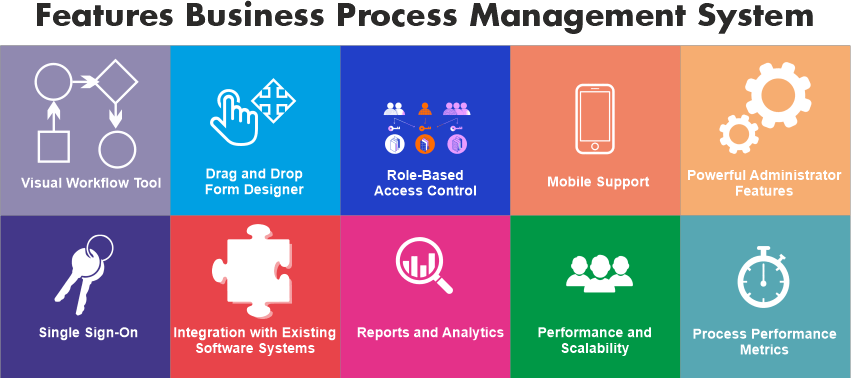
BPM is widely discussed in articles and by scholars from two perspectives: People and Technology. So, the BPM proponents say that technology can support or enable this approach. Through the automation of workflows, Business process management channelize the business. The automation of tasks is done by Robotic Process Automation (RPA) by recording a set of tasks done repetitively by humans. Organizations usually broaden the automation of their businesses with the leverage of both technologies to get good results. DefinitionsPeople tend to have different kinds of definitions for Business Process management. For example, Gartner explains Business process management as "the discipline of management of processes for the development and enhancement of the business performance outputs and operational stability. To create and provide value to the clients and the constituents processes help with organizational boundaries, creating a link between people, information flows, systems, and all the other assets." 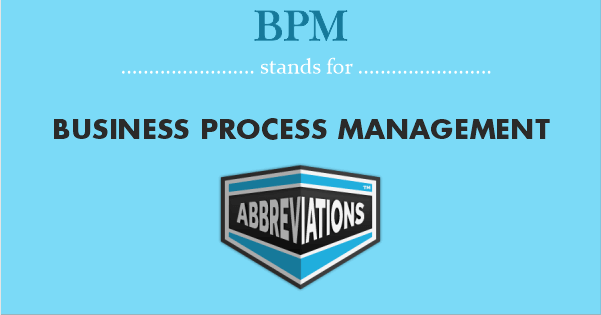
The workflow management coalition, BPM.com and many other sources define Business process management as a discipline involving a mixture of modelling, execution, automation of the tasks, control, measurement and enhancement of the overall business activity. It provides aid to an enterprise to reach its targets for the employees, clients and partners. The alliance of Business Process Management Professionals has a slightly different definition of Business Process Management. They define BPM as a planned approach to achieve stable, targeted goals according to an organization's strategy by going through the following processes: identity, design, execute, document, measure and control both the automated and non-automated business tasks. BPM allows a corporation to match its business processes to its business strategy, improving individual work activities inside a department, within the company, or between companies to improve overall company performance. 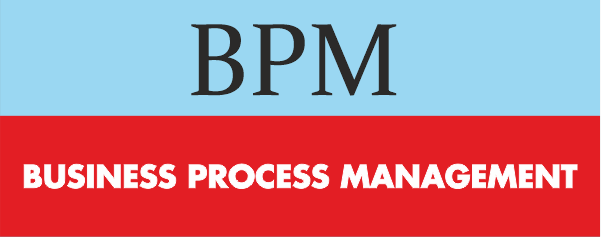
Why is managing company processes crucial?Because successful business processes are essential to an organization's success, business process management is significant. The following are typical illustrations of procedures that assist businesses in achieving their objectives:
What advantages does business process management offer?The two main reasons businesses adopt BPM are because of its systematic approach to managing business processes, which raises both operational effectiveness and work quality. A properly implemented BPM programme can reduce waste, cut errors, save time, enhance compliance, boost agility, promote digital transformation, and ultimately aid in providing customers with better goods and services. According to Isaac Gould, research manager at Nucleus Research, "BPM allows firms to improve workflows by automating laborious procedures, such as data administration, data flows, data input approval processes, and report generation." BPM can also be a powerful management tool for the reasons listed below:
What difficulties does business process management face?Any corporate venture that entails upending the established order is fraught with difficulties. This is particularly true with BPM, where the difficult task of process improvement involves numerous roles, systems, and methods of operation. According to a report by technology reporter George Lawton, who covers technology-enabled business transformation, businesses must be ready for whatever issues they may face and have a strategy for dealing with them in order to fully benefit from BPM. According to the experts Lawton spoke with, the following challenges are the main causes of BPM failures:
ChangesDue to scheduling issues in job shops in the early 20th century, the idea of a business process could be as conventional as the ideas of works, departments, outputs and production. Since the early 1990s, there has been a management and improvement approach with formal definitions and technical modelling (see business process modelling). IT professionals occasionally equate "business process" with integrating application software tasks or managing middleware procedures. 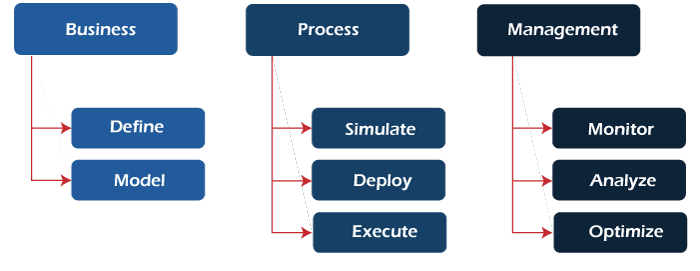
Business process management activities can be arbitrarily categorized into groups like modeling, monitoring, design, optimization, and execution. Life-Cycle of Business Process ManagementDesignIdentification of current processes and the creation of "to-be" processes are included in process design. This stage aims to guarantee a good and effective new design, regardless of whether or not existing procedures are considered. Some focus areas display the flow of the elements that make up the flow, task-off mechanisms, notifications, standard operating procedures, escalations and service level agreements. 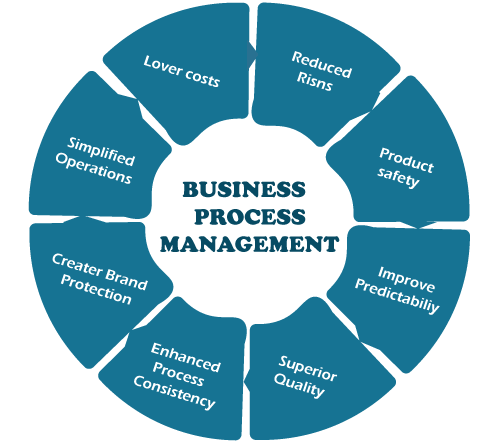
The proposed change may tackle the enterprises' regulatory, market, or competitive difficulties in human-to-human, human-to-system, or system-to-system workflows. The design of a new process for varied applications must synchronize with existing processes and avoid. ModellingThrough simulation, the initial idea is expanded with new covariates. For example, rent or materials costs changes determine how the process might operate under different circumstances). Executing a discovered and modelled business process is the broad definition of business process execution. A business process can be implemented manually, automatically, or using a mix of manual and automated business processes. People operate manual business procedures. Software powers automated business processes. The use of techniques and tools to automate business operations is called business process automation. 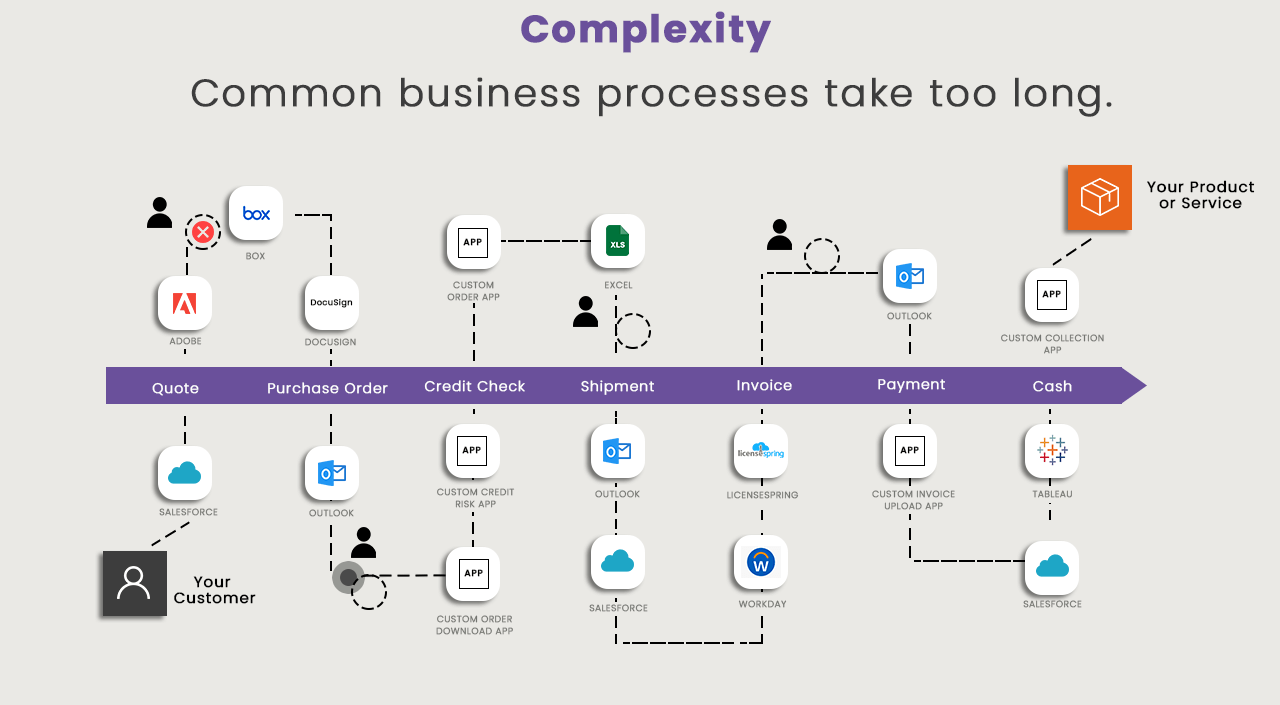
Business process automation is carried out and orchestrated at the business process layer or the consumer presentation layer of the SOA Reference Architecture. The business process layer is where BPM software suites like BPMS, iBPMS, and low-code platforms are positioned. While performing business process automation at the presentation layer, the newly developed robotic process automation software is considered non-intrusive and decoupled from existing application systems. One of the ways to automate processes is to develop or purchase an application that executes the required steps of the process. However, in practice, these applications rarely execute all the steps of the process accurately or completely. Another strategy is integrating combined technological and physical assistance, yet this methodology is more difficult to document because it is more involved. Companies have developed software that defines the full business process in response to these problems. ExecutionExecuting a discovered and modelled business process is the broad definition of business process execution. A business process can be implemented manually, automatically, or using a mix of manual and automated business processes. People operate manual business procedures. Software powers automated business processes. The use of techniques and tools to automate business operations is called business process automation. Business process automation is carried out and orchestrated at the business process layer or the consumer presentation layer of the SOA Reference Architecture. The business process layer is where BPM software suites like BPMS, iBPMS, and low-code platforms are positioned. While performing business process automation at the presentation layer, the newly developed robotic process automation software is considered non-intrusive and decoupled from existing application systems. Creating or purchasing a programme that executes the critical phases of the process is one way to automate processes. Still, these applications rarely execute all of the steps precisely or entirely. Another strategy is to use both software and human input. However, this strategy is more difficult to document because it is more involved. Companies have created software that defines the entire business process (as created in the process design activity) in a computer language that a computer can execute in response to these issues. When a step is too complex to be automated, we can process models through execution engines that automate the processes that come directly from the model. Business Process Modelling Notation (BPMN) offers a front-end capacity for human input and automation. Directly executing a process specification can be simpler and, hence, simpler to improve than either of the preceding methods. However, integrating these technologies IT environment is often not an option because automating a process definition necessitates a flexible and extensive infrastructure. Systems have used business rules to define the rules that govern behaviour, and we can use a business rule engine to control how processes are executed and resolved. MonitoringMonitoring includes keeping track of individual processes so we can quickly observe. We may give that information on their status and figures on how well one or more processes are performing. Knowing the status of a client order-such as whether it has arrived, been delivered, or has been paid-allows for detecting and correcting operational issues. Additionally, we can utilize this data to collaborate with clients and suppliers to enhance their interconnected processes. Examples include developing metrics for how many orders were completed in the previous month or how quickly a customer order is processed. Cycle time, defect rate, and productivity are three categories into which these measurements typically fall. The level of monitoring relies on the data the organization wants to assess and analyse and how it wants it monitored-in real-time, close to real-time, or on an as-needed basis. The monitoring features typically offered by BPMS are extended and expanded, in this case by business activity monitoring (BAM). Process monitoring methodologies and technologies are gathered together in process mining. Process mining aims to analyze and compare event logs obtained from process monitoring with an a priori process model. Process mining enables process analysts to identify differences between the a priori model and the actual process execution and examine bottlenecks. When a business process is ongoing, predictive business process monitoring uses data mining, machine learning, and other forecasting techniques to predict what will happen. The business process estimates future cycle times, compliance problems, etc. Support Vector Machines, Deep Learning methods, and Random Forest are predictive business process monitoring techniques. OptimizationFetching data on production efficiency from the simulation or monitoring stages, finding out the possible or actual obstacles, and then integrating those improvements into the methodology are all part of the process optimization procedure. We can find critical processes and bottlenecks using process mining tools, boosting company growth. ReengineeringReengineering the entire process is typically advised by a company steering committee head of the executive branch or CEO when the system is too complex or inefficient, and optimization is not yielding the intended result. Organizations have utilized business process reengineering (BPR) to improve employees' performance at work. TechnologyOrganizational information (OI) solutions now view BPM as vital for giving real-time, actionable information. We can do a range of interventions regarding this real-time information, including sending alarms or using real-time dashboards to make executive decisions. OI systems use real-time data to automate actions based on pre-established criteria, allowing for the initiation of security processes and exception management procedures. Numerous individuals have seen BPM as the link between Information Technology (IT) and Business. In contrast, reserves in innovation have become more extensively applicable to companies to provide to their working population and "the volume and scope of everyday activities occasionally require its use of software to prototype effectively." The following four elements make up a BPM Suite:
BPM also handles a number of the important IT problems supporting key business drivers, such as:
ConclusionSo, in summary, applying business process management enables organizations to accomplish their objectives more quickly, productively, competitively, and affordably. It offers a systematic strategy for gaining these advantages. Organizations and companies can achieve the best results by adopting Business Process management.
Next TopicFull Form
|
 For Videos Join Our Youtube Channel: Join Now
For Videos Join Our Youtube Channel: Join Now
Feedback
- Send your Feedback to [email protected]
Help Others, Please Share










